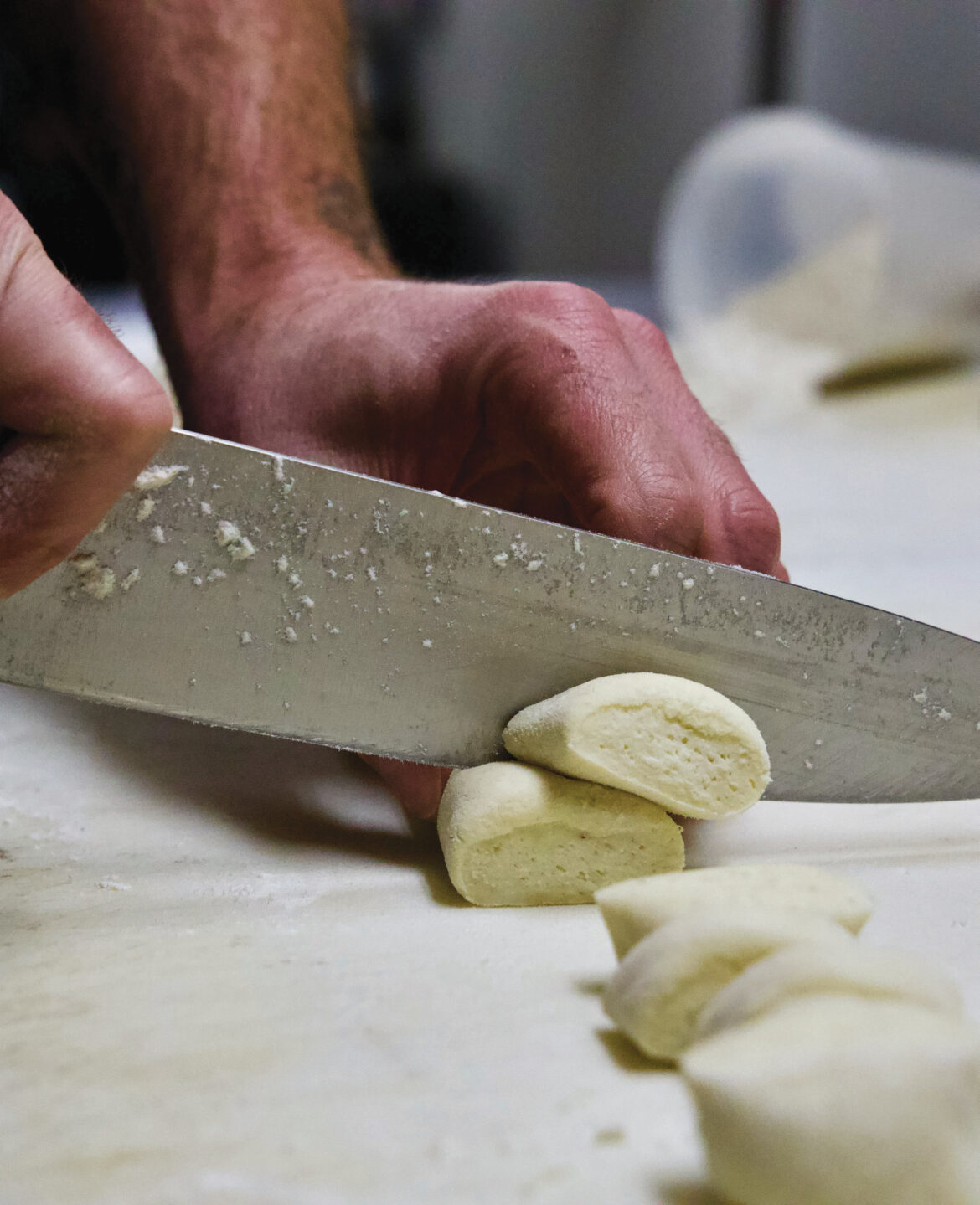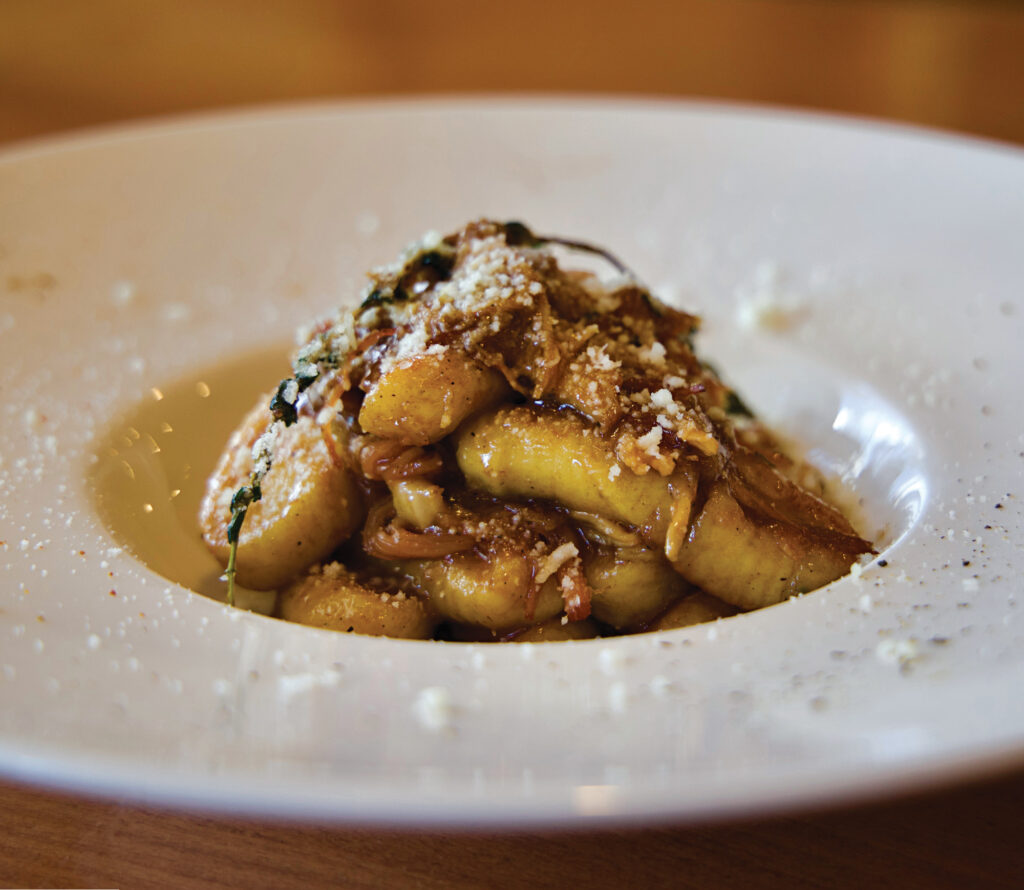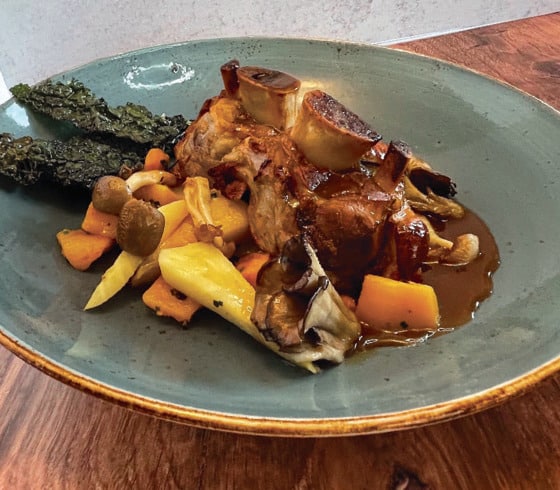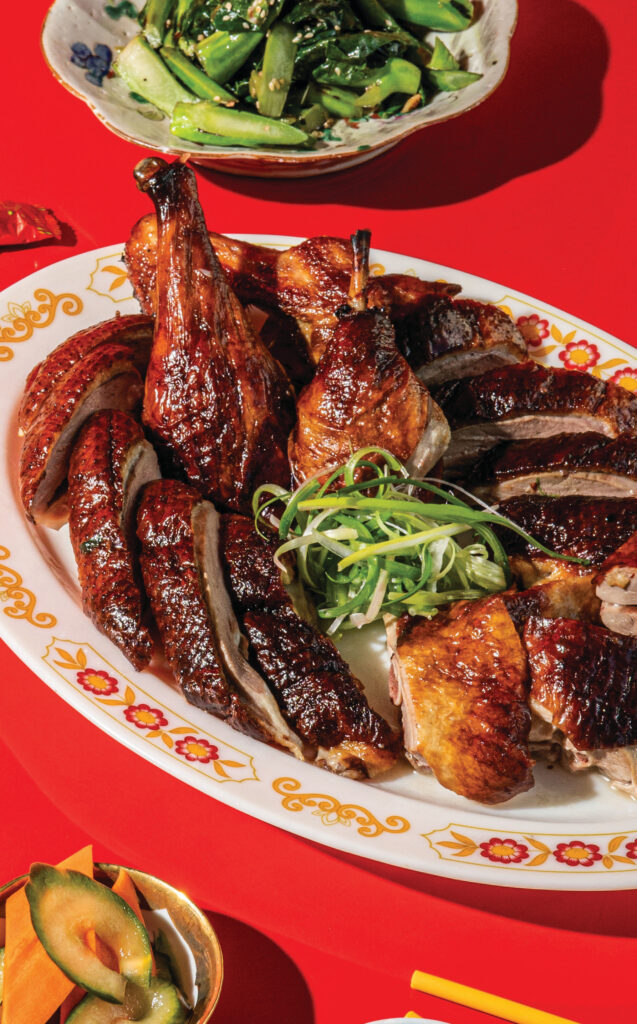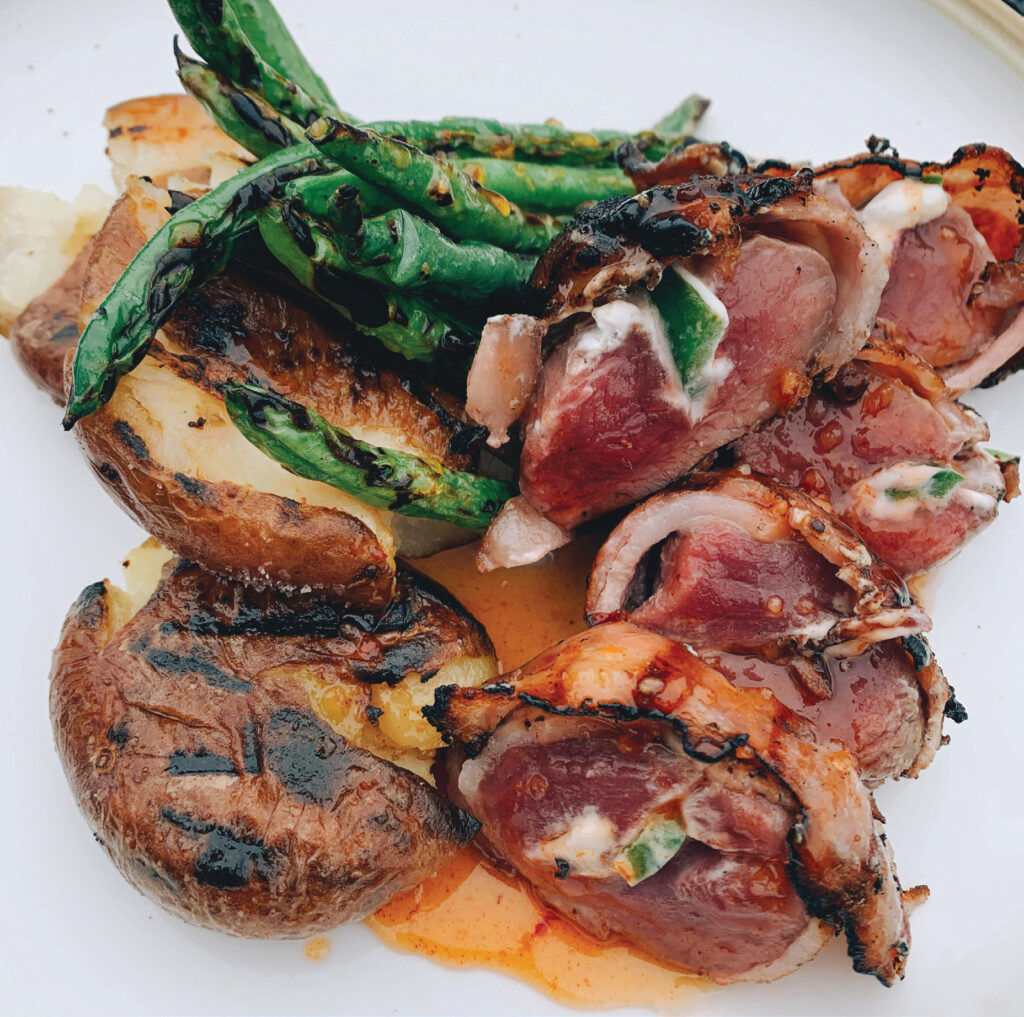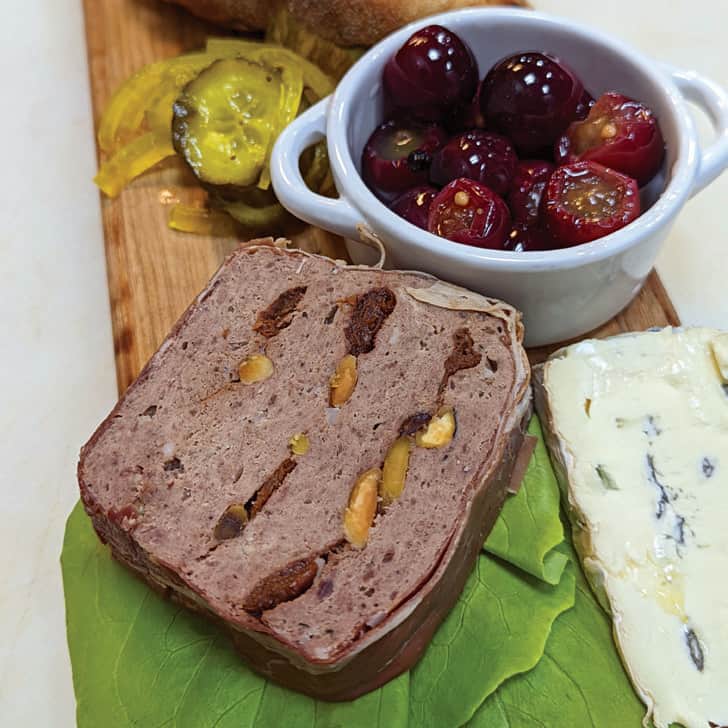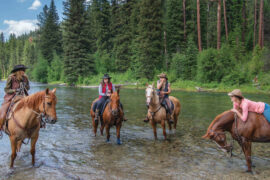5 Game Recipes by Oregon Chefs
written by lean Chen Smith
As the leaves turn hues of gold and marmalade and temperatures drop, it is the optimal time to shift and focus on heartier dishes to nourish the body. What better way to whet your appetite than with five recipes using game indigenous to the region and inspired by Oregon chefs? Time to break out the pots and pans, along with an apron and oven mitts, if you are up for the challenge. These indulgent recipes might also offer inspiration for your upcoming holiday meals!
Ale-Braised Rabbit with Ricotta Gnocchi
Franco Console, Larks Home Kitchen Cuisine (Ashland) // Serves 4–6
Ingredients:
FOR THE BRAISED RABBIT
- 5 rabbits seasoned with herb province, mace, salt and pepper
- 3 house-smoked bacon bellies
- 6 white onions, julienned
- 1 bunch thyme, minced on stick
- 4 blocks demi-glace
- 48 ounces ale or lager
- Chicken stock as needed (about 6 quarts)
FOR THE RICOTTA GNOCCHI
- 4 pounds ricotta
- 8 eggs, lightly beaten
- 4½ cup pecorino, grated
- ½ teaspoon nutmeg, ground
- 5 cups 00 flour
- 2 teaspoons salt
- 1 teaspoon black pepper
FOR THE RICOTTA
- 6 ounces white distilled vinegar
- 4 ounces lemon juice
- 7 quarts whole milk
- 1 quart heavy cream
- 4 tablespoons salt
Instructions:
FOR THE BRAISED RABBIT
- Preheat the oven to 550 degrees. Rub rabbits in olive oil and season then roast for 14 minutes.
- While rabbits are in the oven, sweat onions in a roasting pan with minced thyme. Then add bacon bellies to pan with rabbits, deglaze with beer and add the demi-glace.
- Pour enough chicken stock to just barely submerge the rabbits. Braise covered for 2 hours at 350 degrees low fan. Remove the rabbit and bellies from the liquid and shred the meat, removing all bones. Place the braising liquid into a heavy bottomed pot and reduce by ⅔.
FOR THE RICOTTA GNOCCHI
- Stir together ricotta, eggs, cheese, nutmeg, salt and pepper. Add flour in stages, stirring to form a soft, wet dough. Be careful to not overwork the dough.
- Shape dough on a lightly floured surface into 1-inch-thick ropes. Cut crosswise into 1-inch pieces with a lightly floured knife. Put in one layer on a lightly floured parchment-lined baking sheet and chill for several minutes.
- Cook gnocchi in two batches in a pasta pot of boiling water (3 tablespoons salt for 6 quarts water), adding a few at a time and stirring occasionally, until cooked through and floating (approximately 3 to 4 minutes per batch).
- Lift out with a slotted spoon and shock in an ice bath.
FOR THE RICOTTA
- Run a double layer of cheesecloth under warm water to dampen, then gently squeeze to remove any excess water. Line a colander with the cheesecloth and set in the Cambro.
- Combine the vinegar and lemon juice in a measuring cup.
- Bring the milk and cream to 190 degrees, over medium-low heat, in a medium heavy-bottomed saucepan, stirring frequently to keep the milk mixture from scorching on the bottom. Add half of the vinegar mixture and salt and stir for 10 seconds (you’ll see the milk mixture begin to slightly curdle). Remove from the heat, cover the saucepan with a lid and let sit for 20 minutes.
- Remove the lid and you will see that the milk mixture has separated into small curds. Now, stir in the remaining vinegar mixture and the milk mixture will continue to curdle. Stir for a few minutes. Pour this entire mixture into the prepared colander with cheesecloth. Let drain.
Apple Cider-Braised Wild Boar with Fall Mushrooms
Matt Johnson, Wayfarer (Cannon Beach) // Serves 2-4, Depending on Size of Boar Shanks
Ingredients:
FOR THE BOAR
- 4 wild boar shanks (cut osso buco-style)
- ¼ cup flour
- ½ cup canola oil
- 2 parsnips, peeled and small diced
- 1 yellow onion, small diced
- 2 celery stalks, small diced
- ½ cup whole garlic cloves
- 2 cups white wine
- 2 cups apple cider
- 2 cups beef or game stock
- Bay leaves
- Sprigs fresh thyme
- 2 sprigs fresh rosemary
FOR THE MUSHROOMS
- 1 pound fresh wild or cultivated mushrooms (chanterelles or porcinis work best)
- ¾ cup butter
- Salt and pepper to taste
- 2 tablespoons fresh chives, minced
Instructions:
FOR THE BRAISED BOAR
- Season the shanks with salt and pepper then roll in flour to coat. In a heavy-duty braising pan, heat the oil to just smoking. Brown the shanks on all sides in the oil and then remove.
- Add the parsnips, onion, celery and garlic cloves to the pan. Sauté the vegetables until tender. Add the shanks back to the pan and add the white wine. Reduce the wine by half and add the cider along with the herbs. Bring to a simmer and cover tightly with a lid or foil.
- Place in a 250-degree oven for 2 hours or until the meat is almost falling off the bone. Remove the shanks from the braising liquid and vegetables and set aside.
FOR THE MUSHROOMS
- In a sauté pan, melt ½ cup of the butter and add the mushrooms. Cook until tender, season with salt and pepper and set aside. Strain the vegetables out of the braising liquid and discard them.
- To serve, place the shanks back in the pan, add the strained braising liquid and mushrooms. Bring to a simmer to heat the shanks through. Remove from liquid and serve the shanks over polenta or whipped potatoes.
- Add the other ¼ cup of butter to the simmering braising liquid and mushrooms and season with salt and pepper. Simmer until slightly thickened, spoon the sauce over each shank and garnish with chives.
Cantonese Roast Duck
Steven Chin, YAYA Cantonese BBQ (Portland) // Serves 4–6
Ingredients:
- 1 whole duck (4½-5 pounds)
FOR THE MARINADE
- 4 slices ginger
- 3 whole garlic cloves, lightly crushed
- 3 shallots, roughly diced
- 10 stems of cilantro
- ½ orange, roughly sliced
- 1 tablespoon ground bean sauce
- 1 tablespoon hoisin
- 1 tablespoon Shaoxing wine
FOR DRY SEASONING MIX
- 1 tablespoon sugar
- 1 whole star anise
- ¼ teaspoon white pepper
- 1 tablespoon kosher salt
- 1 teaspoon five-spice powder
FOR THE SCALDING LIQUID
- 2 quarts boiling water
- ¼ cup rice vinegar
FOR THE GLAZE
- 1 quart warm water
- ½ cup honey
- ½ cup rice vinegar
- 2 tablespoons red vinegar
Instructions:
- Combine the dry seasoning ingredients in a bowl and rub the mix into the cavity of the duck. Blend marinade ingredients in a blender until smooth. Pour marinade into the duck cavity and close with a metal skewer, working from the tail up to the belly so marinade does not leak out. Place duck breast-side down on a tray and store in the refrigerator for 24 hours, uncovered.
- After 24 hours, bring 3 quarts of water to a boil. Set aside 1 quart of water in a saucepan to make the glaze, adding the honey, rice vinegar and red vinegar. Make the scalding liquid with the remaining 2 quarts, adding ¼ cup of rice vinegar. With a ladle, pour the scalding liquid over the front and back of the duck. This will help tighten the skin. Then brush the glaze over the front and back of the duck. Wait 5 minutes and reglaze.
- Place the duck breast-side up on a rack on the tray in the refrigerator for another 24 hours. Alternatively, hang the duck upright using one or two S-shaped hooks through the neck of the duck. Place a pan under the duck to catch any drippings. Tip: If the marinade drips out, use a string to tie around the tail area.
- Remove the duck from the refrigerator an hour before roasting to bring it to room temperature. Set up a fan to blow on the duck during this hour to further dry the skin. Preheat the oven to 400 degrees. Place a tray of water at the bottom of the oven.
- Place the breast-side up duck and rack on a baking sheet. Roast for 30 minutes.
- Turn the duck breast-side down, reduce the heat to 350 degrees and cook for 30 minutes. Flip the duck breast-side up for the final 10 minutes at 375 degrees, or until the internal temperature reaches 175 degrees, using an instant-read thermometer placed in the thickest part of the thigh. Remove the duck from the oven and let it rest for 10 minutes.
- Remove the skewer from the duck to allow the juice to drain into a bowl. Strain the juice and skim off any fat. Set the juice aside and serve with duck. Place the duck on a cutting board and cut into pieces. Arrange the duck on a serving platter.
Bacon-Wrapped Stuffed Venison
Danielle Lewis, Castor (Corvallis) // Serves 2
Ingredients:
FOR THE BACON-WRAPPED STUFFED VENISON
- 1 pound venison, leg medallions
- 1 cup Italian dressing, store bought
- 1 jalapeño, cut lengthwise in sticks
- 2 ounces chèvre, rolled in small logs (½ ounce per venison medallion)
- 4–5 pieces sliced pepper bacon
- 9 ounces fingerling potatoes
- 5 ounces green beans, tops picked off
- Olive oil
- Salt and pepper
FOR THE HONEY GLAZE
- 3 tablespoon honey
- 1 tablespoon water
- 1 tablespoon Italian dressing
- Pinch paprika
Instructions:
FOR THE BACON-WRAPPED STUFFED VENISON
- Marinate venison leg medallions in Italian dressing for at least 5 hours and up to 14 hours (12 hours is ideal). Preheat the grill to 450 degrees. While the grill is heating up, wrap the fingerling potatoes in foil with a drizzle of oil, salt & pepper. Place the marinated venison on a cutting board. Using a sharp knife, carefully butterfly the meat.
- Place the foil wrapped potatoes on the hot grill—cooking until soft. Stuff the venison with the chèvre and jalapeño sticks and close with care. Wrap each medallion with bacon and secure with toothpicks.
- About 20 minutes before your potatoes are done, place the bacon wrapped venison on the grill and close the lid, cooking for 5 minutes. Rotate the venison and continue cooking for an additional 5 minutes. Turn the venison again and cook for an additional 5 minutes. You want the bacon to be caramelized and crispy.
- Remove the venison and set on a cutting board and rest for 5 minutes. While the venison is resting, drizzle oil, salt, and pepper on the green beans.
- Remove the toothpick from the venison. Slice on a bias or angle and serve with green beans and roasted potatoes. Drizzle honey glaze on top.
FOR THE HONEY GLAZE
- Mix all the ingredients together in a small pot. Bring to a boil, watching closely. Simmer for 5 minutes. Keep warm.
Elk Terrine with Brandied Cherries and Pistachios
Tim Garling, Recipe Inspired by Brian Polcyn, Tim Garling’s Jackalope Grill (Bend) // Serves 12 Appetizer Portions
Ingredients:
FOR THE ELK
- 1 pound elk, trimmed of gristle and connective tissue and cut into small chunks
- 14 ounces pork fat back, best quality cut into small chunks
- 1½ cup dry Madeira (dry Marsala will work as well)
- 5 ounces German-style smoked prosciutto (Speck)
- 1 tablespoon terrine spice (recipe follows)
- 1 ounce kosher salt
- 2 teaspoon black pepper, coarse ground
- ¼ teaspoon pink salt (optional)
- 1 tablespoon butter
- 2 tablespoons garlic, minced
- 2 tablespoons shallot, minced
- 3 egg whites (large eggs)
- ½ cup heavy cream
- 1 cup dried Montmorency sour cherries
- 1 cup brandy
- ½ cup raw pistachios
FOR THE TERRINE SPICE MIX
- 2 tablespoons white peppercorns
- ¼ teaspoon freshly grated nutmeg
- 10 whole cloves
- ¼ teaspoon cinnamon
- ½ teaspoon ground ginger
- ½ teaspoon thyme, whole
- ¼ teaspoon piment d’ Espelette
- 1 medium size bay leaf, crumbled
Instructions:
FOR THE ELK
- Three important considerations when preparing this dish: Keep the meat and metal parts cold, season boldly and don’t overcook. On the first day, combine the elk, fat back, terrine spice, salt, black pepper, and pink salt (optional) in a mixing bowl. Stir well to coat. Add the Madeira, stir, cover and refrigerate overnight. In another bowl, add the brandy to the dried Montmorency cherries, cover with cling film and refrigerate overnight.
- On the second day, preheat the oven to 300 degrees. Place the metal meat grinder parts and the food processor parts in the freezer. Strain the liquid from the cherries and the elk, reserving both liquids. Spread the elk and fatback on a half sheet pan and place in the freezer. In a saucepan, melt the butter and sauté the shallots over medium heat until fragrant and translucent. Add the reserved liquid from the elk and cherries and, over medium high heat, reduce it to a little less than a cup. It should be very thick and syrupy. Transfer to a small bowl and refrigerate.
- Next, set up the meat grinder with the metal parts from the freezer. Using the small die (⅛-inch holes), grind the elk and fat back together. Then transfer the grind to the cold food processor bowl. Add the egg whites and the reduced chilled syrup. Purée until well combined then, with the motor running, add the cream in a thin stream. Process until the mixture is uniform in color, scraping the bowl as needed.
- Transfer the mix to a chilled bowl, add the pistachios and mix until uniformly distributed. Refrigerate.
- Line a 1½-quart terrine with cling film (a small application of spray oil helps). Then line the terrine with German-style smoked prosciutto. Layer the elk and pistachio mix in increments with cherries. Repeat until the terrine is full. Fold the prosciutto over the top followed by the cling film. Place the covered terrine in a 150-degree water bath and set it in the oven. Cook for about an hour or until a thermometer inserted into the middle registers 145 degrees. Cut a piece of cardboard to fit the top of the terrine, cover it with foil and weight it with two or three food tins to compress the terrine as it cools. Take it easy and use only a judicious weight. You don’t want to squeeze the flavoring juices out. After it comes to room temperature, refrigerate overnight.
FOR THE TERRINE SPICE MIX
- Quatre Épices (French for “four spices”) is the usual starting point for seasoning a terrine. Curiously, Quatre Épices is usually five or more spices but almost always includes white pepper, ground cloves and ground ginger. If your elk is strongly flavored, crushed juniper berries are an appropriate addition. Put all the ingredients in a spice mill and process until finely ground. Store in a cool, dark place.


